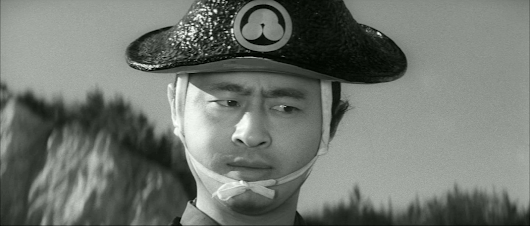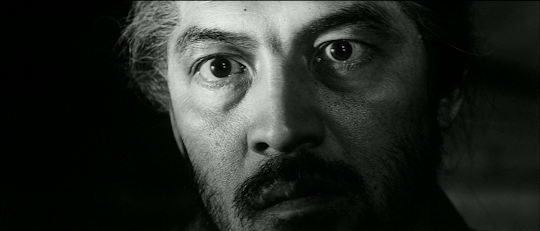Escape from Hell / 無宿人別帳/ Mushukunin-betsucho (1963)
Obscure Japanese Film #93
 Keiji Sada
Keiji SadaDuring the winter of1802-3, a group of convicts are transported in individual bamboo cages to theisland of Sado, where they have been sentenced to hard labour draining a gold mine.Among them is Yaju (Keiji Sada), a formerly honourable samurai who became acriminal after the woman he loved, Kumi (Mariko Okada), was forced into amarriage with the more senior Kurozuka (Hiroshi Nihonyanagi).
 Hiroshi Nihonyanagi and Mariko Okada
Hiroshi Nihonyanagi and Mariko Okada
In an unfortunatecoincidence, Kurozuka becomes the new governor of the mine, while his schemingsubordinate Kojuro (Hiroyuki Nagato) informs Kumi that her former lover Yaju isamong the prisoners. Always planning ahead, Kojuro also decides it could be tohis advantage to push his own mistress, Rin (Sachiko Hidari), into the arms ofthe inexperienced new magistrate.
 Hiroyuki Nagato and Sachiko Hidari
Hiroyuki Nagato and Sachiko Hidari
Meanwhile, theprisoners find themselves not only working in life-threatening conditions, butalso treated brutally by the foreman (Ko Nishimura) and his henchman Hachizo (ToranosukeTennoji).
 Rentaro Mikuni and Kanemon Nakamura
Rentaro Mikuni and Kanemon Nakamura
However, two trusties,Shinpei (Rentaro Mikuni) and Seibei (Kanemon Nakamura) are more sympathetic anddo what they can for the men. Seibei also has a daughter, Miyo (Masuyo Iwamoto*),who treats the men when they are wounded, but is raped by one named Senta(Masahiko Tsugawa) for her pains. When conditions become unbearable, the mendecide to make a desperate escape attempt headed by Shinpei – but can the trusty betrusted?
This Shochikuproduction takes its Japanese title from the title of Seicho Matsumoto’s 1958 shortstory collection containing the story ‘Tobo’ (‘Escape’) upon which the film is partlybased. The title is hard to translate into English, but in the Edo periodduring which the stories were set, the mushukuninwere people who had been removed from the family register, and each of thestories in Matsumoto’s collection was centred on a character who was some kindof social outcast, i.e. a homeless person or criminal. However, the film isalso partly based on a second Matsumoto story, ‘Sado runinko’ (‘Sado Exile Journey’),published in 1957. I’m uncertain whether there was really a mass escape attemptat the Sado gold mine, but it’s certainly true that, during the late Edoperiod, the authorities would round up vagrants and send them to do forcedlabour there. In any case, the man who used this interesting historical settingalong with other elements of the two Matsumoto stories and turned it all into afine screenplay was Hideo Oguni, known for his work on many of Kurosawa’s mostfamous films.
The director, KazuoInoue (1924-2011), had worked as an assistant to Minoru Shibuya, Yuzu Kawashimaand Yasujiro Ozu before becoming a Shochiku director himself in 1954. Escape from Hell is the 11thof 12 films he made for the company before going freelance in 1964, after whichhe seems to have been unable to sustain a career in the declining Japanese filmindustry. Although he managed to direct a further eight pictures, most of thesewere comedies of little note, the exception being his final film, a documentaryabout Ozu entitled I Lived But… (1983).Apart from allowing some of the actors in the smaller parts to overact, hisdirection of Escape from Hell isimpressive and he clearly knew how to get the most out of a scene.
Another factor whichmakes Escape from Hell worthseeking out is the host of well-knownfaces among the cast, even including Tora-san actor Kiyoshi Atsumi as a convictwith a snoring problem. Hiroyuki Nagato from Pigs and Battleships is especially good as the devious Kojuro,constantly figuring all the angles to his own advantage, although Mariko Okadais sadly wasted in her role, which gives her little to do. Used to betteradvantage is Rentaro Mikuni, who gives one of the strongest performances hereas an escaping convict. This fact, together with Sachiko Hidari’s appearance asa giggling former prostitute, suggests that Tomu Uchida saw the film and wasinfluenced in his casting for A Fugitivefrom the Past (1965).
However, the real revelation for me among the cast wasKeiji Sada – I’ve seen many of his films and always liked him, but would neverhave imagined Sada as the tough, unshaven, moody samurai he plays here, a rolehe pulls off very well indeed. It’s a reminder of what a loss to Japanesecinema his premature death in a car crash the following year was.
*Sometimes incorrectlylisted as Tayo Iwamoto in English.








